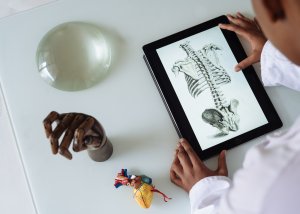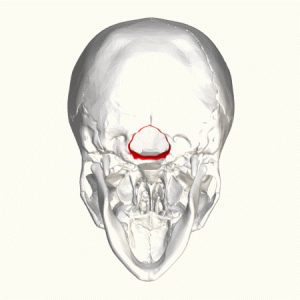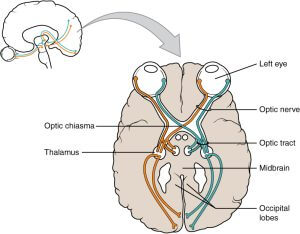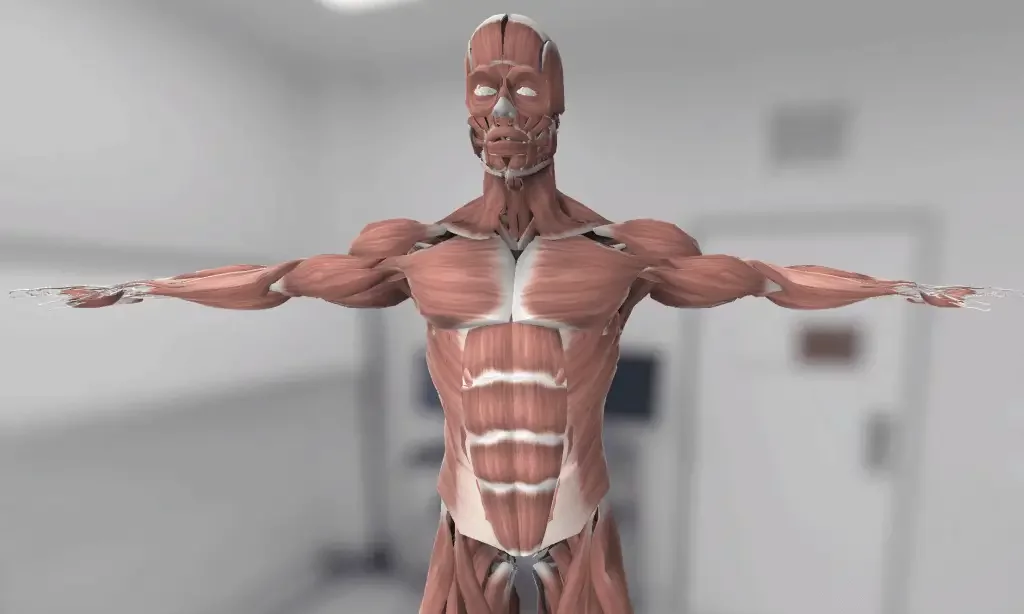
臂丛神经解释
概述
The brachial plexus is an intricate network of nerves in the neck and shoulder that carries signals for movement and sensation from the spinal cord to the arms and hands. The brachial plexus consists of several parts: trunks, roots, cords, branches, and divisions.
All the nerves in the brachial plexus come from the spinal cord. Thus any severe brachial plexus injury affects the spinal cord as well.
结构
根
Nerves originating from the neck portion of the vertebrae (cervical vertebrae) are known as cervical nerves. These nerves divide into 2 divisions that supply the front and the back of the body (anterior and posterior rami respectively).
The brachial plexus begins as roots of the cervical and thoracic anterior rami nerve fibers. It includes the fifth, 6th, 7th, 8th, and first thoracic vertebrae.
All of the brachial plexus roots combine to form brachial trunks as it proceeds down the neck.
Trunks
- Upper trunk – forms due to a combination of fifth and 6th cervical vertebrae roots.
- Middle trunk – forms from only the 7th cervical vertebrae root.
- Lower trunk – forms due to the combination of the first and 8th cervical vertebrae roots.
All of these trunks are further divided into two divisions (dorsal and ventral). The dorsal division supplies the back of the upper limb, while the ventral supplies the front of the upper limb. The trunks divisions join to form brachial plexus cords.
Cords
- Lateral cord – forms by the union of middle and upper trunks’ ventral division.
- Medial cord – forms from the lower trunk’s ventral division. The medial cord forms from only one division, unlike other cords.
- 后索 - 由于所有臂丛神经干中所有背侧部分的组合而形成。这条绳索的存在是由于三个部门
Nerve supply by the brachial plexus
根分支
The nerve roots of the brachial plexus have branches that supply muscles of the neck and shoulder:
- Dorsal scapular nerve.
- Long thoracic nerve.
- Phrenic nerve
树干分支
Branches of the trunks only originate from the upper trunk of the plexus, which gives off two further branches:
- Suprascapular nerve
- Subclavian nerve
线分支
来自侧索的分支
- lateral pectoral nerve
- musculocutaneous nerve
- part of the median nerve
来自内侧索的分支
- medial pectoral nerve
- medial cutaneous nerve of arm
- ulnar nerve
- part of the median nerve
来自后索的分支
Other than the brachial plexus branches, the upper limb has innervation from other cervical nerve fibers
Muscles supplied by the brachial plexus
- The roots of brachial plexus give innervation to serratus anterior, levator scapulae, and rhomboid muscles.
- 上躯干向锁骨下肌、冈下肌和冈上肌发出神经支配。
- The lateral cord innervates the pectoralis major and minor, coracobrachialis, Biceps brachii, and brachialis muscles.
- The posterior cord supplies subscapularis, deltoid, teres minor, triceps brachii, anconeus, supinator, brachioradialis, and latissimus dorsi muscles.
- The medial cord innervates the pectoralis, forearm and hand muscles.
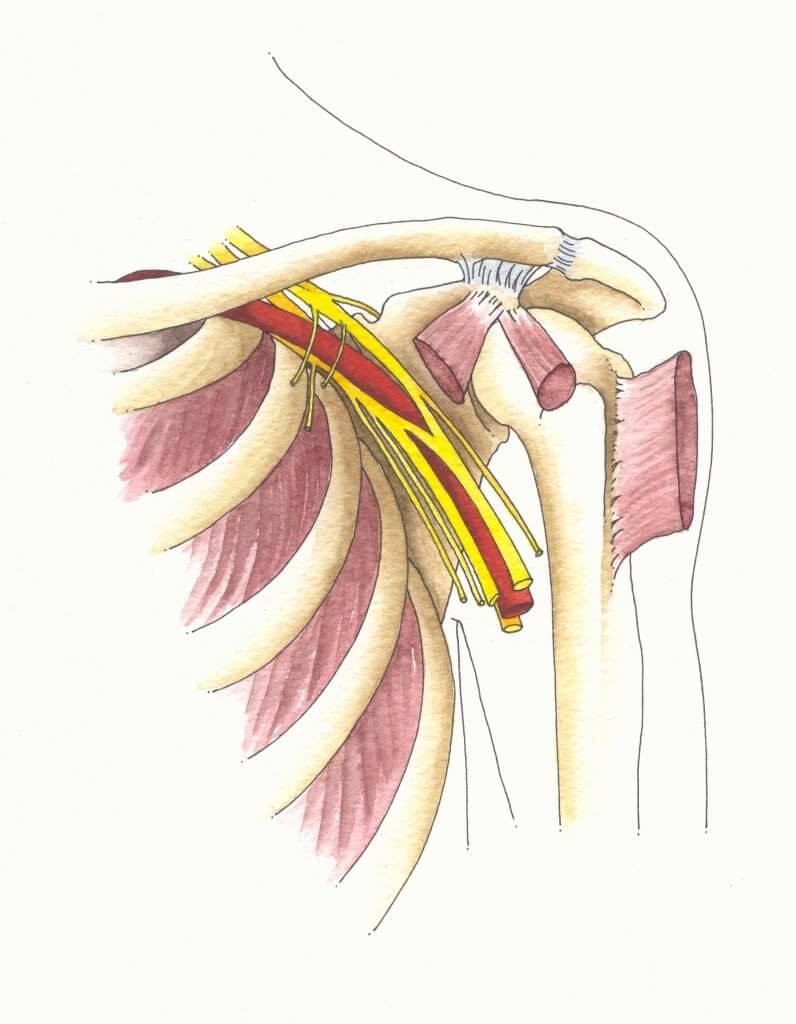
Diseases associated with the brachial plexus
臂丛神经的几种损伤导致不同的情况:
Erb的瘫痪
In the brachial plexus, there’s a point at the upper trunk referred to as the Erb’s point, it is where six nerves meet. Any injury to the upper trunk of the brachial plexus causes Erb’s paralysis. The mainly involved nerves in Erb’s paralysis are branches originating from the fifth and 6th cervical vertebrae.
The most commonly paralyzed muscles in this condition are deltoid, bicep brachii, brachioradialis, and brachialis muscles.
In Erb’s palsy, the arms tend to hang on the sides close to the body and are turned inwards such that the hand appears as if the individual is asking for a tip. This appearance is called the policeman’s or waiter’s tip appearance of the hands.
前锯肌损伤
Serratus anterior nerve is a branch of the brachial plexus. In serratus anterior nerve injury, a person cannot raise or flex their arm above 90 degrees or raise it overhead because the serratus anterior muscle is a major participant in this movement.
Causes of this injury include :
- Sudden heavy shoulder pressure from above e.g. from a falling object.
- Overuse of the serratus anterior muscle by repeated carrying heavy objects on the shoulders.
The most prominent feature of this injury is the winging of the 肩胛骨. Winging of the scapula is the abnormal prominence of the scapula bone. In the normal anatomical body, the 肩胛骨 is kept close to the chest wall through muscles that pull it against the thoracic wall. (One of these muscles is serratus anterior)
Serratus anterior nerve injury can also cause disability in punching and pushing actions. During the pushing attempts, winging of the scapula becomes very prominent.
克伦普克的瘫痪
This type of paralysis is due to injury to the lower trunk of the brachial plexus. Physical trauma to the arm, such as a sudden pull of the arm to the side, a fall from height, or pulling on a baby’s arm too hard during birth injury can be causes of this paralysis.
The mainly involved nerves in Klumpke’s paralysis are nerves originating from the 8th and first thoracic vertebrae.
Muscles paralyzed in this condition are the hand, forearm, and finger muscles. Kulumke’s paralysis causes a claw-hand appearance due to hyperextension of the hand and finger joints following muscle paralysis.
Other changes that can also occur include:
- Loss of the skin’s sensory effects
- Loss of the ability to sweat
The skin with sensory problems is relatively warmer and also drier than the parts of the skin due to sweating loss and sympathetic activity loss. Long-standing Klumpke’s paralysis causes scaliness or dryness of the skin, easy cracking of the finger and nails, and a decrease in the size of the finger pulps.
- Orebaugh SL,威廉姆斯 BA。臂丛神经解剖:正常和变异。科学世界杂志。 2009 年 4 月 28 日;9:300-12。
- Leinberry CF,韦贝 MA。臂丛神经解剖。手部诊所。 2004 年 2 月 1 日;20(1):1-5。
- Partridge BL、Katz J、Benirschke K. 臂丛神经鞘的功能解剖:对麻醉的影响。麻醉学。 1987 年 6 月 1 日;66(6):743-7。
- Johnson EO、Vekris M、Demesticha T、Soucacos PN。臂丛神经解剖学:其形成的正常和变异解剖学。外科和放射解剖学。 2010 年 3 月;32(3):291-7。
- Fazan VP, Amadeu AD, Caleffi AL, Rodrigues Filho OA。臂丛神经在其形成和主要分支上的变化。 Acta Cirrurgica Brasileira。 2003;18:14-8。
- Mian A, Chaudhry I, Huang R, Rizk E, Tubbs RS, Loukas M. 臂丛神经麻醉:相关解剖学、并发症和解剖学变异的综述。临床解剖学。 2014 年 3 月;27(2):210-21。
- 布罗迪 IA,威尔金斯 RH。 Erb的麻痹。神经病学档案。 1969 年 10 月 1 日;21(4):442-。
- 维特 JM,弗拉托 EL。长胸神经损伤。临床骨科及相关研究。 1999 年 11 月 1 日(368):17-27。
- Al-Qattan MM、Clarke HM、Curtis CG。 Klumpke 的出生性麻痹:它真的存在吗?手外科杂志。 1995 年 2 月;20(1):19-23。
Health Literacy Hub 网站上共享的内容仅供参考,并不旨在取代您所在州或国家/地区的合格医疗专业人员提供的建议、诊断或治疗。鼓励读者确认其他来源提供的信息,并就他们可能对自己的健康有任何疑问寻求合格医生的建议。健康素养中心不对因应用所提供材料而产生的任何直接或间接后果负责。

